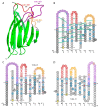IMGT® and 30 Years of Immunoinformatics Insight in Antibody V and C Domain Structure and Function
- PMID: 31544835
- PMCID: PMC6640715
- DOI: 10.3390/antib8020029
IMGT® and 30 Years of Immunoinformatics Insight in Antibody V and C Domain Structure and Function
Abstract
At the 10th Human Genome Mapping (HGM10) Workshop, in New Haven, for the first time, immunoglobulin (IG) or antibody and T cell receptor (TR) variable (V), diversity (D), joining (J), and constant (C) genes were officially recognized as 'genes', as were the conventional genes. Under these HGM auspices, IMGT®, the international ImMunoGeneTics information system®, was created in June 1989 at Montpellier (University of Montpellier and CNRS). The creation of IMGT® marked the birth of immunoinformatics, a new science, at the interface between immunogenetics and bioinformatics. The accuracy and the consistency between genes and alleles, sequences, and three-dimensional (3D) structures are based on the IMGT Scientific chart rules generated from the IMGT-ONTOLOGY axioms and concepts: IMGT standardized keywords (IDENTIFICATION), IMGT gene and allele nomenclature (CLASSIFICATION), IMGT standardized labels (DESCRIPTION), IMGT unique numbering and IMGT Collier de Perles (NUMEROTATION). These concepts provide IMGT® immunoinformatics insights for antibody V and C domain structure and function, used for the standardized description in IMGT® web resources, databases and tools, immune repertoires analysis, single cell and/or high-throughput sequencing (HTS, NGS), antibody humanization, and antibody engineering in relation with effector properties.
Keywords: IMGT; IMGT Collier de Perles; IMGT unique numbering; IMGT-ONTOLOGY; antibody; complementarity determining region; immunogenetics; immunoglobulin; immunoinformatics; paratope.
Conflict of interest statement
The authors declare no conflict of interest. The funders had no role in the design of the study; in the collection, analyses, or interpretation of data; in the writing of the manuscript, or in the decision to publish the results.
Figures




References
-
- Lefranc M.-P., Lefranc G. The Immunoglobulin FactsBook. Academic Press; London, UK: 2001.
-
- Lefranc M.-P., Lefranc G. The T Cell Receptor FactsBook. Academic Press; London, UK: 2001.
-
- Lefranc M.-P. The IMGT unique numbering for Immunoglobulins, T cell receptors and Ig-like domains. Immunologist. 1999;7:132–136.
Publication types
LinkOut - more resources
Full Text Sources
Other Literature Sources

